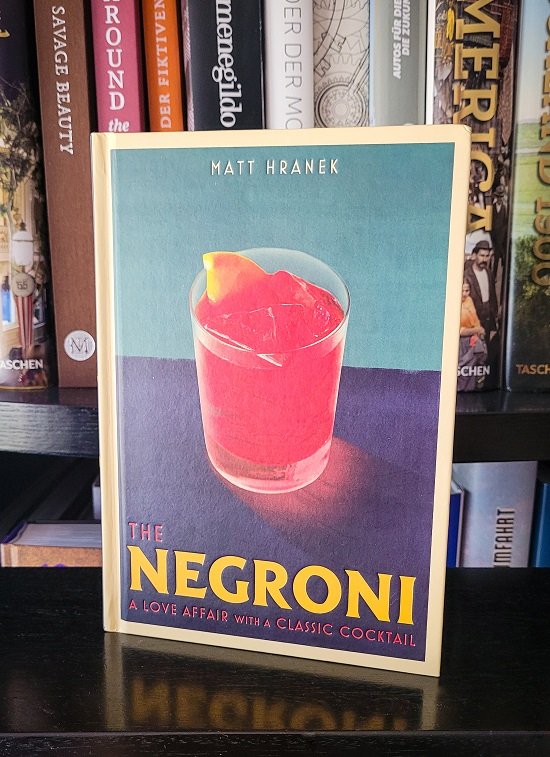The Negroni - Matt Hranek
The Negroni: A Love Affair With A Classic Cocktail
Matt Hranek / 160 Pages / June 2021
This time we're reviewing one of those cocktail books that revolve entirely around a specific drink or its formula. It's always an interesting concept, in my opinion, and these days there are special Old Fashioned, Martini and a few other books, some of which we will be reviewing in the future.
Incidentally, there are now several on the Negroni alone, this one, a fairly short one by David T. Smith, which cannot be recommended, and a similarly long one (like the one discussed here) by legend Gary Reagan. But now finally to the actual work of Mr. Hranek.
Who is Matt Hranek? I actually knew him before I bought the book, and only realized afterward that it was the same person I had already seen on various social media posts, often with a Negroni and a good piece of meat in each hand. Among other things, Hranek is a magazine owner and publishes the gentleman/lifestyle magazine “WM Brown”, writes regularly for other publications and is now probably best known for his very successful book (also in my library) “A Man & His Watch”. As you can see, his interests are wide-ranging and cover the typical topics “For the cultivated gentleman”, as it would have been called in the past.
From the short, 3-page introduction, you can already tell that this is someone with writing experience, his texts are consistently pleasant and stimulating to read. Personal and yet with an elegant distance, the small but subtle details in language sometimes make all the difference. In that introduction, he also summarizes the myths surrounding the Negroni in just a few sentences, even though a little more depth would have been nice. Of course, he also describes his moment of love at first sight when it comes to the legendary cocktail. Italy, a hotel bar (the name of the hotel has been forgotten), la dolce vita in its purest form.
This love of Italy and, of course, the historical connection to the drink is also evident in the following part, which briefly introduces “The Essential Components”. Meaning exactly that, on 1–2 pages each he explains what bitters, vermouth, gin, garnish, and ice are and what is important about them (concerning the Negroni). Of course, tips, and brand recommendations are also given (mostly easy to buy, you shouldn't expect a long insider tip list), which you can and should pay attention to. As far as vermouth is concerned, he of course explains that his personal taste and his connection to the moment in Italy leads him to only use Italian vermouth. At the same time, he does not rule out other options for the reader.
This is followed by the recipes, around 30, sorted by geographical location of the bar. These include 3-4 classic variations or predecessors of the drink, such as the Americano and Sbagliato, as well as the author's Signature Serve. With the recipes, but also in the book in general, the important factor or added value is that the author almost always works specifically with brands and the aim is to distinguish the signature Negronis through sometimes very subtle differences. At times 3–4 recipes can use almost or exactly the same Negroni ratio, only with one you use a different gin, with another a changed red vermouth, and so on. Sometimes the riffs go a little further, with mezcal or as a frappé, but overall I would have liked to see a few more progressive interpretations in a special book on the subject. Overall, a mezcal variant (which continues to use a type of vermouth, whether bianco, dry or red, and a bitter liqueur) or similar gimmicks remain the most creative thing in the book; you can tell that there is a lot of respect for the tradition of the original and that's okay in itself.
At the same time, of course, this also means that the book makes more sense if you are also a big Negroni fan and are prepared to get several different versions of red vermouth and different gins to mix up. If you take liberties with the substitution of brands, 5-6 different recipes no longer make any sense at all, as they otherwise use the same ratios, as already mentioned.
Alongside the recipes, there are stylish pictures and photos with mostly accompanying quotes inserted throughout the book from start to finish, as you can see in the first picture above. These range from his travel photography to historical Campari advertisements. Some of these quotes are historical, e.g., from Orson Welles, about — you guessed it — the Negroni, and some are apparently (according to online information) from interviews with the author. It's a shame that no more than the two sentences are printed, if that's the case. Those reach from bartenders, to authors or for example Anthony Bourdain.
Following the recipes is a short page with mostly typical Italian snacks to accompany your Negroni (without a recipe, simply a list of possible accompaniments, another case of “would have been nice”), from olives to panini with specific toppings. There is also a “Black Book”, meaning a list of bar recommendations for future Negroni visits, in keeping with the general travel theme, all of which Hranek has personally visited several times.
Conclusion:
In the end, Mr. Hranek's little book on the Negroni falls perfectly into the “nice as a small gift” category, in which many bar books released in recent years now seem to fall. The market has become quite large, many people want to have at least contributed something. The book is nicely presented, infused with his noticeable sense of design and aesthetics, and you can see the honest passion for the drink. I just wish there had been 5-6 more exciting twists on the Negroni, more progressive, more diverse. Also, 1-2 more pages on the success story and in particular the modern revival of the Negroni would have been appropriate. However, for the €10-12 that you can often find the book for on sale, you can give it as a gift or get it for yourself without hesitation. For people who want more pages about the techniques and bar craft of the Negroni, Gary Reagan's book on the Negroni is the better choice.




